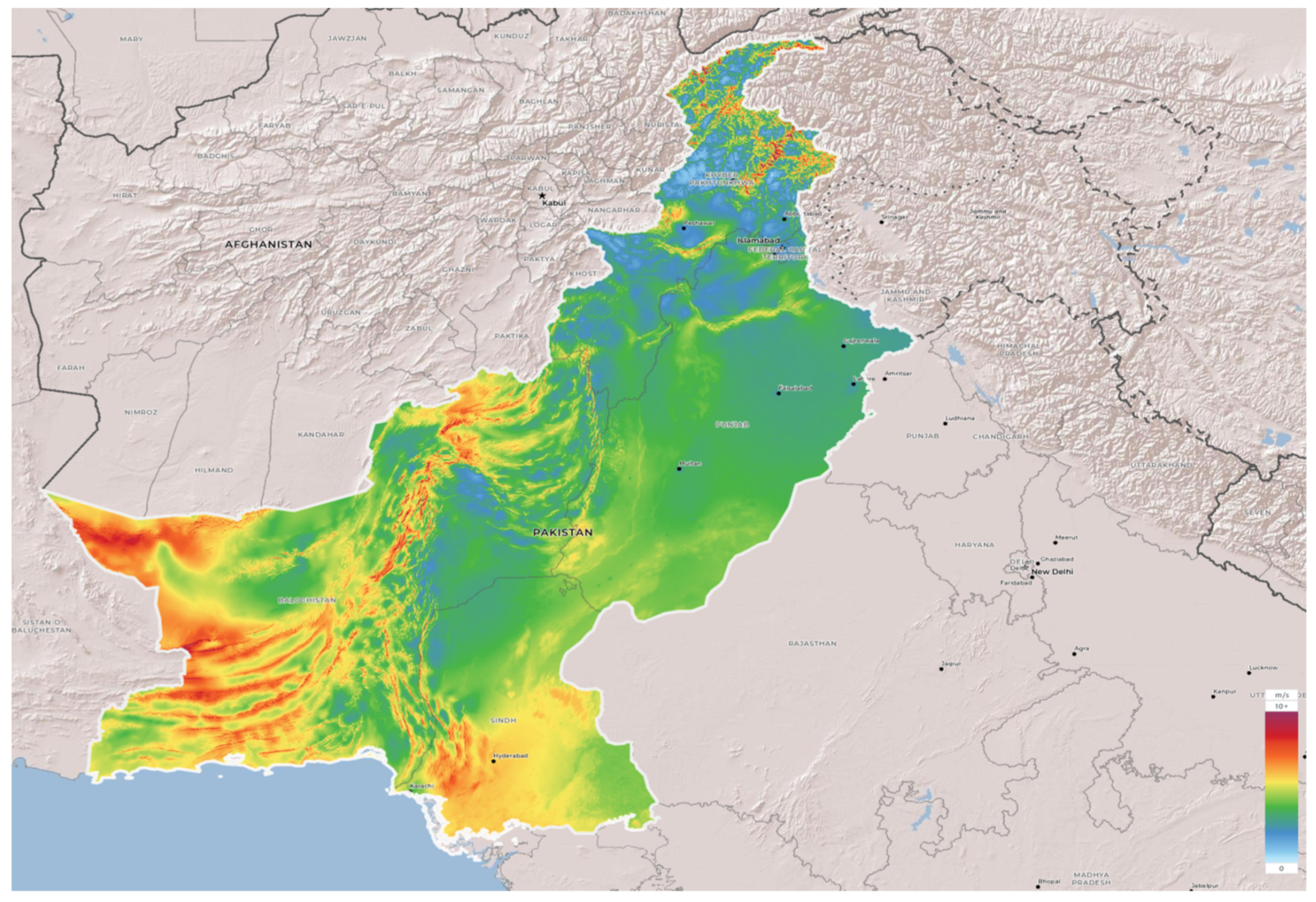An Overview of the Current Energy Situation of Pakistan and the Way Forward towards Green Energy Implementation
Abstract
1. Introduction
- (i).
- Problem statement
- (ii).
- Study contributions
- (iii).
- Paper structure
2. Energy Situation and Challenges of Pakistan
3. Energy Sector of Pakistan
3.1. Institutional Structure
3.2. Energy Planning/Modeling Studies Undertaken by the Government of Pakistan
3.3. Power and Energy Policies of Pakistan
4. Potential of Renewable Energy in Pakistan
Assessment of Renewable Energy: Related Studies
5. Energy Planning Policies and Summary
6. Research Issues and Knowledge Gap
- Pakistan has been facing energy crises for more than a decade, owing to poor energy planning and governance issues;
- Energy crises in the country have forced thousands of industries to shut down operations, affecting industrial production and the livelihoods of thousands of families;
- The energy crisis has been a major drag on the economy and a serious impediment to growth, with an estimated cost of 10% of the GDP over the past 5 years;
- Pakistan’s energy crisis, if not tackled at both the operating and strategic levels in the immediate future, might become a national security threat;
- Therefore, in addition to planning and developing a conventional source of energy, Pakistan should harness the potential of its abundant renewable energy resources, i.e., solar, wind, hydro, and biomass, as attractive alternative sources of energy to constitute a substantial share of its overall energy supply;
- These renewable energy sources remain untapped to their full potential, and only account for 2–4% of the total energy mix.
Author Contributions
Funding
Data Availability Statement
Acknowledgments
Conflicts of Interest
References
- MoD Survey of Pakistan Ministry of Defence. Available online: http://www.surveyofpakistan.gov.pk/ (accessed on 20 July 2020).
- WBG World Bank Data Bank. Available online: https://databank.worldbank.org/reports.aspx?source=2&country=PAK# (accessed on 8 March 2021).
- IEA. Market Report Series Renewables 2018 Analysis and Forecast to 2023; IEA: Paris France, 2018. [Google Scholar]
- Now, D. COP27 Kicks Off as U.N. Head Warns “We Are on a Highway to Climate Hell”|Democracy Now! Available online: https://www.democracynow.org/2022/11/7/headlines/cop27_kicks_off_as_un_head_warns_we_are_on_a_highway_to_climate_hell (accessed on 8 November 2022).
- Mirjat, N.H.; Uqaili, M.A.; Harijan, K.; Das Valasai, G.; Shaikh, F.; Waris, M. A Review of Energy and Power Planning and Policies of Pakistan. Renew. Sustain. Energy Rev. 2017, 79, 110–127. [Google Scholar] [CrossRef]
- Khatri, S.A.; Uqaili, M.A.; Khanji, H. Ever Increasing Electricity Demand of Pakistan and Future Power Generation Options. In Proceedings of the 7th International conference on Environmentally Sustainable Development, New York, NY, USA, 21–26 June 2020; pp. 1–8. [Google Scholar]
- HDIP. Pakistan Energy Year Book (2019), Hydrocarbon Development Institute of Pakistan (HDIP); HDIP: Islamabad, Pakistan, 2019. [Google Scholar]
- NEPRA. State of Industry Report 2018; NEPRA: Islamabad, Pakistan, 2018.
- GoP. Pakistan Economic Survey 2019–2020; Ministry of Finance, Government of Pakistan: Islamabad, Pakistan, 2020.
- MoE Ministry of Energy (Power Division) Government of Pakistan. Available online: http://www.mowp.gov.pk/ (accessed on 15 November 2022).
- MoE Ministry of Energy (Petroleum Division) Government of Pakistan. Available online: https://petroleum.gov.pk/ (accessed on 15 November 2022).
- Mirjat, N.H.; Uqaili, M.A.; Harijan, K.; Mustafa, M.W.; Rahman, M.M.; Khan, M.W.A. Multi-Criteria Analysis of Electricity Generation Scenarios for Sustainable Energy Planning in Pakistan. Energies 2018, 11, 757. [Google Scholar] [CrossRef]
- Mirjat, N.H.; Uqaili, M.A.; Harijan, K.; Das Valasai, G.; Mondal, M.A.H.; Sahin, H. Long-Term Electricity Demand Forecast and Supply Side Scenarios for Pakistan (2015–2050): A LEAP Model Application for Policy Analysis. Energy 2018, 165, 512–526. [Google Scholar] [CrossRef]
- NEPRA. State of Industry Report 2022, GOP-Government of Pakistan; NEPRA: Islamabad, Pakistan, 2022.
- Ministry of Energy. Renewable Energy Policy 2015; U.S. Department of Energy: Washington, DC, USA, 2015.
- WBG Global Wind Atlas, World Bank Group. Available online: https://globalwindatlas.info/ (accessed on 12 December 2018).
- Tahir, Z.R.; Asim, M. Surface Measured Solar Radiation Data and Solar Energy Resource Assessment of Pakistan: A Review. Renew. Sustain. Energy Rev. 2018, 81, 2839–2861. [Google Scholar] [CrossRef]
- WBG. Biomass Resource Mapping in Pakistan, World Bank Group; WBG: Washington, DC, USA, 2016. [Google Scholar]
- Harijan, K. Modeling and Analysis of the Potential Demand for Renewable Sources of Energy in Pakistan. Ph.D. Thesis, Mehran University of Engineering and Technology, Jamshoro, Pakistan, 2008. [Google Scholar]
- Ghaffar, M.A. The Energy Supply Situation in the Rural Sector of Pakistan and the Potential of Renewable Energy Technologies. Renew. Energy 1995, 6, 941–976. [Google Scholar] [CrossRef]
- Siemek, J.; Nagy, S.; Rychlicki, S. Estimation of Natural-Gas Consumption in Poland Based on the Logistic-Curve Interpretation. Appl. Energy 2003, 75, 1–7. [Google Scholar] [CrossRef]
- Evrendilek, F.; Ertekin, C. Assessing the Potential of Renewable Energy Sources in Turkey. Renew. Energy 2003, 28, 2303–2315. [Google Scholar] [CrossRef]
- Uemura, Y.; Kai, T.; Natori, R.; Takahashi, T.; Hatate, Y.; Yoshida, M. Potential of Renewable Energy Sources and Its Applications in Yakushima Island. Renew. Energy 2004, 29, 581–591. [Google Scholar] [CrossRef]
- Lund, P. Market Penetration Rates of New Energy Technologies. Energy Policy 2006, 34, 3317–3326. [Google Scholar] [CrossRef]
- Harijan, K.; Memon, M.; Uqaili, M.A.; Mirza, U.K. Potential Contribution of Ethanol Fuel to the Transport Sector of Pakistan. Renew. Sustain. Energy Rev. 2009, 13, 291–295. [Google Scholar] [CrossRef]
- Bhutto, A.W.; Harijan, K.; Qureshi, K.; Bazmi, A.A.; Bahadori, A. Perspectives for the Production of Ethanol from Lignocellulosic Feedstock—A Case Study. J. Clean. Prod. 2015, 95, 184–193. [Google Scholar] [CrossRef]
- Forouzanfar, M.; Doustmohammadi, A.; Menhaj, M.B.; Hasanzadeh, S. Modeling and Estimation of the Natural Gas Consumption for Residential and Commercial Sectors in Iran. Appl. Energy 2010, 87, 268–274. [Google Scholar] [CrossRef]
- Xu, J.; Li, L.; Zheng, B. Wind Energy Generation Technological Paradigm Diffusion. Renew. Sustain. Energy Rev. 2016, 59, 436–449. [Google Scholar] [CrossRef]
- Dalla Valle, A.; Furlan, C. Forecasting Accuracy of Wind Power Technology Diffusion Models across Countries. Int. J. Forecast. 2011, 27, 592–601. [Google Scholar] [CrossRef]
- Harijan, K.; Uqaili, M.A.; Memon, M.; Mirza, U.K. Forecasting the Diffusion of Wind Power in Pakistan. Energy 2011, 36, 6068–6073. [Google Scholar] [CrossRef]
- Melikoglu, M. Vision 2023: Forecasting Turkey’s Natural Gas Demand between 2013 and 2030. Renew. Sustain. Energy Rev. 2013, 22, 393–400. [Google Scholar] [CrossRef]
- Farooq, M.K.; Kumar, S.; Shrestha, R.M. Energy, Environmental and Economic Effects of Renewable Portfolio Standards (RPS) in a Developing Country. Energy Policy 2013, 62, 989–1001. [Google Scholar] [CrossRef]
- Shami, S.H.; Ahmad, J.; Zafar, R.; Haris, M.; Bashir, S. Evaluating Wind Energy Potential in Pakistan’s Three Provinces, with Proposal for Integration into National Power Grid. Renew. Sustain. Energy Rev. 2016, 53, 408–421. [Google Scholar] [CrossRef]
- Umaid Ali, S.; Khan, R.; Syed, A.M. Analysis of Wind Energy Potential and Optimum Wind Blade Design for Jamshoro Wind Corridor. Mehran Univ. Res. J. Eng. Technol. 2017, 36, 781–788. [Google Scholar] [CrossRef][Green Version]
- Kamran, M. Current Status and Future Success of Renewable Energy in Pakistan. Renew. Sustain. Energy Rev. 2018, 82, 609–617. [Google Scholar] [CrossRef]
- Farooqui, S.Z. Prospects of Renewables Penetration in the Energy Mix of Pakistan. Renew. Sustain. Energy Rev. 2014, 29, 693–700. [Google Scholar] [CrossRef]
- Udhayakumar; Raju, K.; Madurai Elavarasan, R.; Mihet-Popa, L. An Assessment of Onshore and Offshore Wind Energy Potential in India Using Moth Flame Optimization. Energies 2020, 13, 3063. [Google Scholar] [CrossRef]
- Teimourian, A.; Bahrami, A.; Teimourian, H.; Vala, M.; Oraj Huseyniklioglu, A. Assessment of Wind Energy Potential in the Southeastern Province of Iran. Energy Sources Part A Recover. Util. Environ. Eff. 2020, 42, 329–343. [Google Scholar] [CrossRef]
- Nazari, M.A.; El Haj Assad, M.; Haghighat, S.; Maleki, A. Applying TOPSIS Method for Wind Farm Site Selection in Iran. In Proceedings of the 2020 Advances in Science and Engineering Technology International Conferences, Dubai, United Arab Emirates, 4 February–9 April 2020; IEEE: Piscataway, NJ, USA, 2020. [Google Scholar] [CrossRef]
- Shoaib, M.; Siddiqui, I.; Rehman, S.; Khan, S.; Alhems, L.M. Assessment of Wind Energy Potential Using Wind Energy Conversion System. J. Clean. Prod. 2019, 216, 346–360. [Google Scholar] [CrossRef]
- Glasson, J. Community Benefits and UK Offshore Wind Farms: Evolving Convergence in a Divergent Practice. J. Environ. Assess. Policy Manag. 2020, 22, 2150001. [Google Scholar] [CrossRef]
- Cai, T.; Dong, M.; Liu, H.; Nojavan, S. Integration of Hydrogen Storage System and Wind Generation in Power Systems under Demand Response Program: A Novel p-Robust Stochastic Programming. Int. J. Hydrogen Energy 2022, 47, 443–458. [Google Scholar] [CrossRef]
- Khatri, S.A.; Harijan, K.; Uqaili, M.A.; Shah, S.F.; Mirjat, N.H.; Kumar, L. Solar Photovoltaic Potential and Diffusion Assessment for Pakistan. Energy Sci. Eng. 2022, 10, 2452–2474. [Google Scholar] [CrossRef]
- Khatri, S.A.; Harijan, K.; Uqaili, M.A.; Shah, S.F.; Mirjat, N.H.; Kumar, L. A Logistic Modelling Analysis for Wind Energy Potential Assessment and Forecasting Its Diffusion in Pakistan. Front. Energy Res. 2022, 10, 1–15. [Google Scholar] [CrossRef]
- Bargur, J.; Mandel, A. Energy Consumption and Economic Growth in Israel: Trend Analysis (1960–1979); Ministry of Energy and Infrastructure: Dubai, United Arab Emirates, 1981. [Google Scholar]
- Gonzales Chavez, S.; Xiberta Bernat, J.; Llaneza Coalla, H. Forecasting of Energy Production and Consumption in Asturias (Northern Spain). Energy 1999, 24, 183–198. [Google Scholar] [CrossRef]
- Filippini, M.; Hunt, L.C. US Residential Energy Demand and Energy Efficiency: A Stochastic Demand Frontier Approach. Energy Econ. 2012, 34, 1484–1491. [Google Scholar] [CrossRef]
- Sharma, D.P.; Chandramohanan Nair, P.S.; Balasubramanian, R. Demand for Commercial Energy in the State of Kerala, India: An Econometric Analysis with Medium-Range Projections. Energy Policy 2002, 30, 781–791. [Google Scholar] [CrossRef]
- Johannesen, N.J.; Kolhe, M.; Goodwin, M. Relative Evaluation of Regression Tools for Urban Area Electrical Energy Demand Forecasting. J. Clean. Prod. 2019, 218, 555–564. [Google Scholar] [CrossRef]
- Leo, D.S.; Caramuta, P.; Curci, P.; Cosmi, C. Regression Analysis for Energy Demand Projection: An Application to TIMES-Basilicata and TIMES-Italy Energy Models. Energy 2020, 196, 117058. [Google Scholar] [CrossRef]
- Islam, M.A.; Che, H.S.; Hasanuzzaman, M.; Rahim, N.A. Energy Demand Forecasting. In Energy for Sustainable Development: Demand, Supply, Conversion and Management; Academic Press: Cambridge, MA, USA, 2019; pp. 105–123. ISBN 9780128146453. [Google Scholar]
- O’Neill, B.C.; Desai, M. Accuracy of Past Projections of US Energy Consumption. Energy Policy 2005, 33, 979–993. [Google Scholar] [CrossRef]
- Lee, C.C.; Chang, C.P. The Impact of Energy Consumption on Economic Growth: Evidence from Linear and Nonlinear Models in Taiwan. Energy 2007, 32, 2282–2294. [Google Scholar] [CrossRef]
- Papalexopoulos, A.D.; Hesterberg, T.C. A Regression-Based Approach to Short-Term System Load Forecasting. IEEE Trans. Power Syst. 1990, 5, 1535–1547. [Google Scholar] [CrossRef]
- Charytoniuk, W.; Chen, M.S.; Van Olinda, P. Nonparametric Regression Based Short-Term Load Forecasting. IEEE Power Eng. Rev. 1997, 17, 56. [Google Scholar] [CrossRef]
- Al-Hamadi, H.M.; Soliman, S.A. Long-Term/Mid-Term Electric Load Forecasting Based on Short-Term Correlation and Annual Growth. Electr. Power Syst. Res. 2005, 74, 353–361. [Google Scholar] [CrossRef]
- De Martino Jannuzzi, G.; Schipper, L. The Structure of Electricity Demand in the Brazilian Household Sector. Energy Policy 1991, 19, 879–891. [Google Scholar] [CrossRef]
- Harris, J.L.; Liu, L.M. Dynamic Structural Analysis and Forecasting of Residential Electricity Consumption. Int. J. Forecast. 1993, 9, 437–455. [Google Scholar] [CrossRef]
- Tunç, M.; Çamdali, Ü.; Parmaksizoglu, C. Comparison of Turkey’s Electrical Energy Consumption and Production with Some European Countries and Optimization of Future Electrical Power Supply Investments in Turkey. Energy Policy 2006, 34, 50–59. [Google Scholar] [CrossRef]
- Al-Ghandoor, A.; Al-Hinti, I.; Jaber, J.O.; Sawalha, S.A. Electricity Consumption and Associated GHG Emissions of the Jordanian Industrial Sector: Empirical Analysis and Future Projection. Energy Policy 2008, 36, 258–267. [Google Scholar] [CrossRef]
- Suganthi, L.; Samuel, A.A. Energy Models for Demand Forecasting—A Review. Renew. Sustain. Energy Rev. 2012, 16, 1223–1240. [Google Scholar] [CrossRef]
- Suganthi, L.; Williams, A. Renewable Energy in India—A Modelling Study for 2020–2021. Energy Policy 2000, 28, 1095–1109. [Google Scholar] [CrossRef]
- Iniyan, S.; Suganthi, L.; Samuel, A.A. Energy Models for Commercial Energy Prediction and Substitution of Renewable Energy Sources. Energy Policy 2006, 34, 2640–2653. [Google Scholar] [CrossRef]
- Sengupta, R. Energy Modelling for India, Towards a Policy for Commercial Energy. Plan. Comm. Gov. India. 1993, 1, 1–9. [Google Scholar]
- Arsenault, E.; Bernard, J.T.; Carr, C.W.; Genest-Laplante, E. A Total Energy Demand Model of Québec. Forecasting Properties. Energy Econ. 1995, 17, 163–171. [Google Scholar] [CrossRef]
- Das Valasai, G. Modelling and Analysis of the Least Cost Power Generation Options for Pakistan. Ph.D. Thesis, Mehran University of Engineering & Technology, Jamshoro, Pakistan, 2016. [Google Scholar]
- Aydinalp, M.; Ismet Ugursal, V.; Fung, A.S. Modeling of the Appliance, Lighting, and Space-Cooling Energy Consumptions in the Residential Sector Using Neural Networks. Appl. Energy 2002, 71, 87–110. [Google Scholar] [CrossRef]
- Sözen, A.; Arcaklioglu, E. Prediction of Net Energy Consumption Based on Economic Indicators (GNP and GDP) in Turkey. Energy Policy 2007, 35, 4981–4992. [Google Scholar] [CrossRef]
- Ermis, K.; Midilli, A.; Dincer, I.; Rosen, M.A. Artificial Neural Network Analysis of World Green Energy Use. Energy Policy 2007, 35, 1731–1743. [Google Scholar] [CrossRef]
- Lu, I.J.; Lin, S.J.; Lewis, C. Grey Relation Analysis of Motor Vehicular Energy Consumption in Taiwan. Energy Policy 2008, 36, 2556–2561. [Google Scholar] [CrossRef]
- Lee, Y.S.; Tong, L.I. Forecasting Energy Consumption Using a Grey Model Improved by Incorporating Genetic Programming. Energy Convers. Manag. 2011, 52, 147–152. [Google Scholar] [CrossRef]
- Pao, H.T.; Tsai, C.M. Modeling and Forecasting the CO2 Emissions, Energy Consumption, and Economic Growth in Brazil. Energy 2011, 36, 2450–2458. [Google Scholar] [CrossRef]
- Haldenbilen, S.; Ceylan, H. Genetic Algorithm Approach to Estimate Transport Energy Demand in Turkey. Energy Policy 2005, 33, 89–98. [Google Scholar] [CrossRef]
- Ying, L.C.; Pan, M.C. Using Adaptive Network Based Fuzzy Inference System to Forecast Regional Electricity Loads. Energy Convers. Manag. 2008, 49, 205–211. [Google Scholar] [CrossRef]
- Shahid, M.; Ullah, K.; Imran, K.; Mahmood, A.; Arentsen, M. LEAP Simulated Economic Evaluation of Sustainable Scenarios to Fulfill the Regional Electricity Demand in Pakistan. Sustain. Energy Technol. Assess. 2021, 46, 101292. [Google Scholar] [CrossRef]
- Ahmad, S.; Muhammad, S.R.S. Predicting Future Energy Requirements of Punjab (Pakistan) Agriculture Sector Using LEAP Model. World Appl. Sci. J. 2010, 8, 833–838. [Google Scholar]
- Ediger, V.Ş.; Akar, S. ARIMA Forecasting of Primary Energy Demand by Fuel in Turkey. Energy Policy 2007, 35, 1701–1708. [Google Scholar] [CrossRef]
- Ho, S.L.; Xie, M. The Use of ARIMA Models for Reliability Forecasting and Analysis. Comput. Ind. Eng. 1998, 35, 213–216. [Google Scholar] [CrossRef]
- Smelser, N.J.; Baltes, P.B. International Encyclopedia of the Social and Behavioral Sciences; Elsevier: Amsterdam, The Netherlands, 2015; Volume 53. [Google Scholar]
- Box, G.E.P.; Jenkins, G.M.; Bacon, D.W. Models for Forecasting Seasonal and Nonseasonal Time Series. In Advanced Seminar on Spectral Analysis of Time Series; Wiley: Hoboken, NJ, USA, 1967; pp. 271–311. [Google Scholar]
- Hamzaçebi, C. Improving Artificial Neural Networks’ Performance in Seasonal Time Series Forecasting. Inf. Sci. 2008, 178, 4550–4559. [Google Scholar] [CrossRef]
- Kumar, P.; Shah, S.F.; Uqaili, M.A.; Kumar, L.; Zafar, R.F. Forecasting of Drought: A Case Study of Water-Stressed Region of Pakistan. Atmos 2021, 12, 1248. [Google Scholar] [CrossRef]
- Bhutto, A.W.; Ahmed Bazmi, A.; Qureshi, K.; Harijan, K.; Karim, S.; Shakil Ahmad, M. Forecasting the Consumption of Gasoline in Transport Sector in Pakistan Based on ARIMA Model. Environ. Prog. Sustain. Energy 2017, 36, 1490–1497. [Google Scholar] [CrossRef]
- Zhang, P.G. Time Series Forecasting Using a Hybrid ARIMA and Neural Network Model. Neurocomputing 2003, 50, 159–175. [Google Scholar] [CrossRef]
- Andersen, T.; Bollerslev, T.; Hadi, A. ARCH and GARCH Models. In Wiley StatsRef Statistics Reference Online; Wiley Online Library: Hoboken, NJ, USA, 2014. [Google Scholar]
- WBG. Pakistan GDP Growth Rate, World Bank Group; WBG: Washington, DC, USA, 2022. [Google Scholar]
- Komal, R.; Abbas, F. Linking Financial Development, Economic Growth and Energy Consumption in Pakistan. Renew. Sustain. Energy Rev. 2015, 44, 211–220. [Google Scholar] [CrossRef]
- Islam, F.; Shahbaz, M.; Ahmed, A.U.; Alam, M.M. Financial Development and Energy Consumption Nexus in Malaysia: A Multivariate Time Series Analysis. Econ. Model. 2013, 30, 435–441. [Google Scholar] [CrossRef]
- Yazdanie, M.; Zurich, T.R.-E. Undefined Renewable Energy in Pakistan: Policy Strengths, Challenges & the Path Forward. ETH Zur. 2010, 2, 112–119. [Google Scholar]
- Nawaz, W.; Arif, M.; University, B.M.-S. 2 undefined Energy Crises Mitigation through Available Energy Potential in Pakistan. Super. Univ. 2014, 1, 1–10. [Google Scholar]
- Mirza, U.K.; Ahmad, N.; Harijan, K.; Majeed, T. Identifying and Addressing Barriers to Renewable Energy Development in Pakistan. Renew. Sustain. Energy Rev. 2009, 13, 927–931. [Google Scholar] [CrossRef]
- NEPRA. State of Industry Report 2015, GOP-Government Of Pakistan; NEPRA: Islamabad, Pakistan, 2015.
- Qazi, U.; Jahanzaib, M.; Ahmad, W.; Hussain, S. An Institutional Framework for the Development of Sustainable and Competitive Power Market in Pakistan. Renew. Sustain. Energy Rev. 2017, 70, 83–95. [Google Scholar] [CrossRef]
- HDIP Pakistan Energy Yearbook 2015. Hydrocarbon Development Institute of Pakistan (HDIP); HDIP: Islamabad, Pakistan, 2015. [Google Scholar]
- Kiani, K. Circular Debt Touches Rs800bn: Pepco-Business-DAWN.COM. Available online: https://www.dawn.com/news/1350245 (accessed on 25 November 2022).
- NTDC Daily Operational Energy Data. Available online: https://ntdc.gov.pk/ (accessed on 25 November 2022).
- Kessides, I.N. Chaos in Power: Pakistan’s Electricity Crisis. Energy Policy 2013, 55, 271–285. [Google Scholar] [CrossRef]
- Studies, I.N.-T.J. of D. undefined Pathologies of Development Practice: Higher Order Obstacles to Governance Reform in the Pakistani Electrical Power Sector. Taylor Fr. 2016, 52, 950–964. [Google Scholar] [CrossRef]
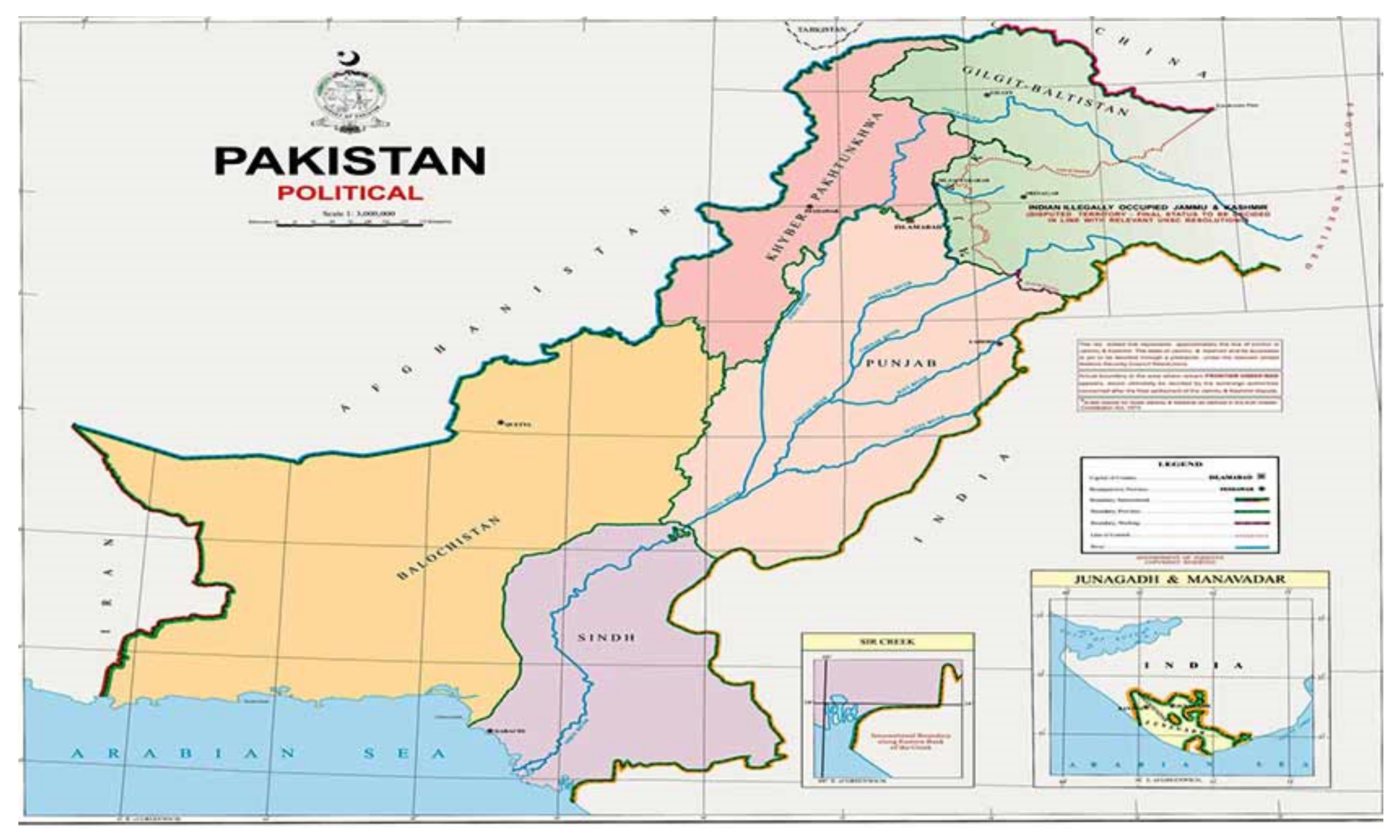
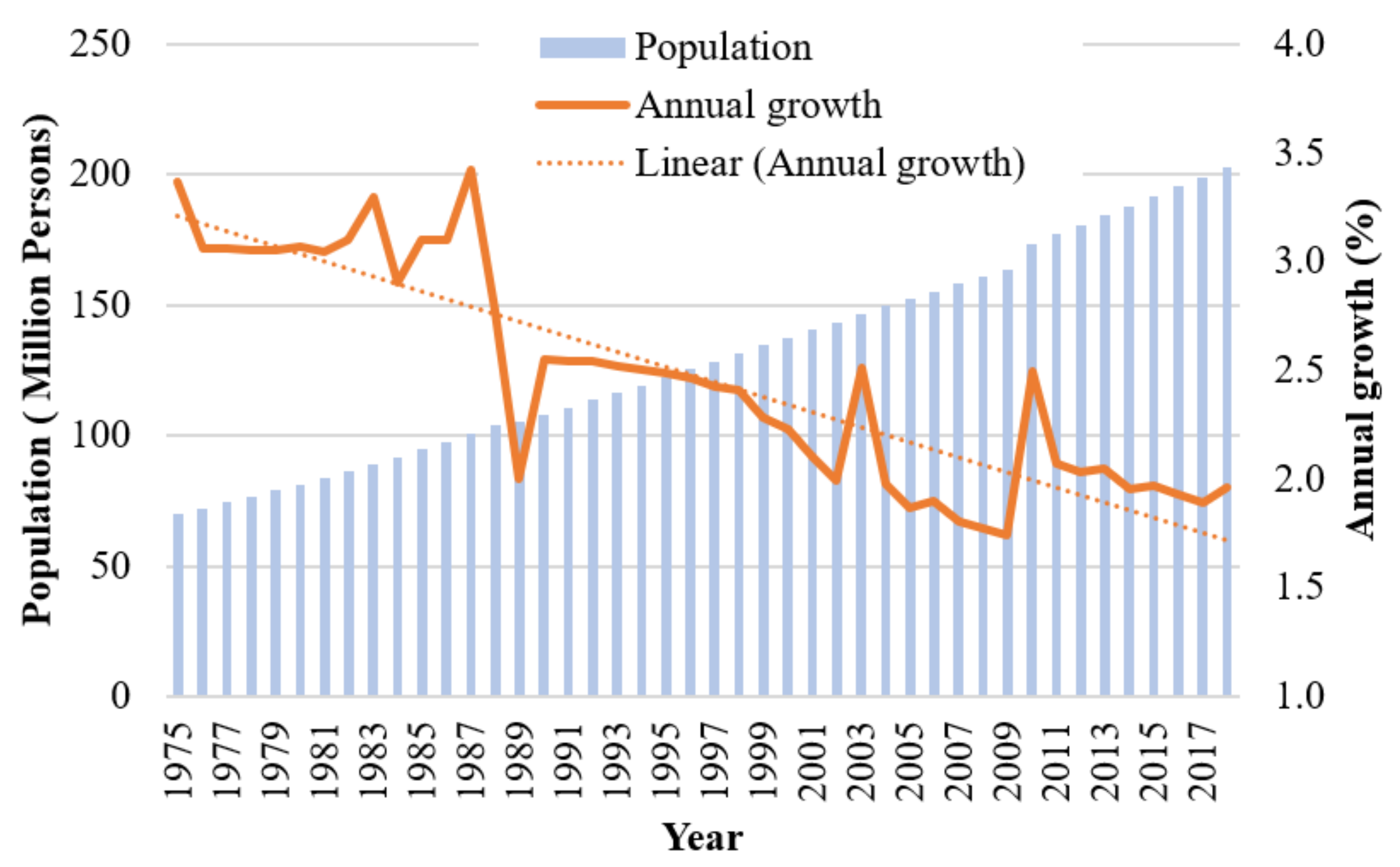

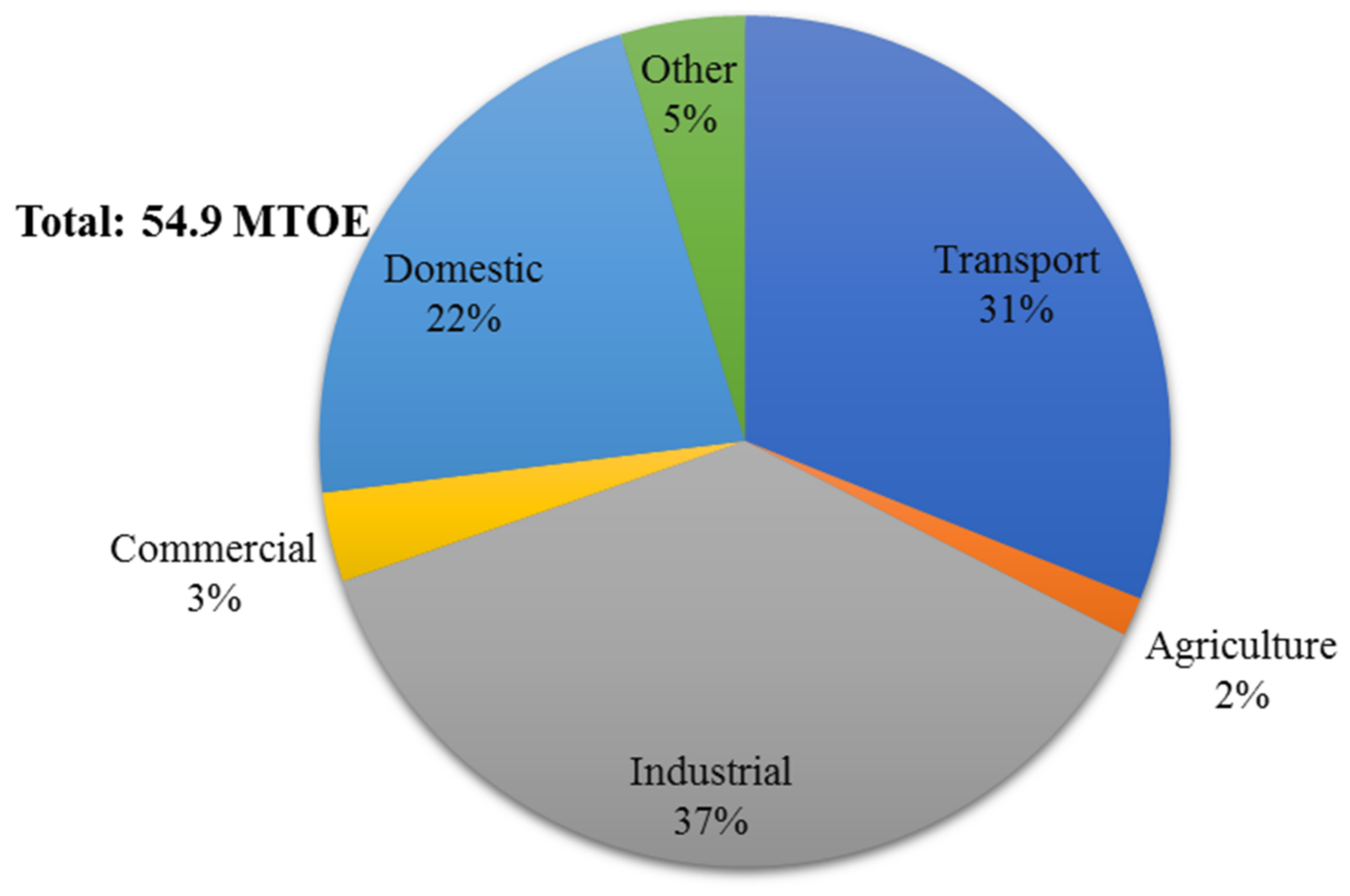
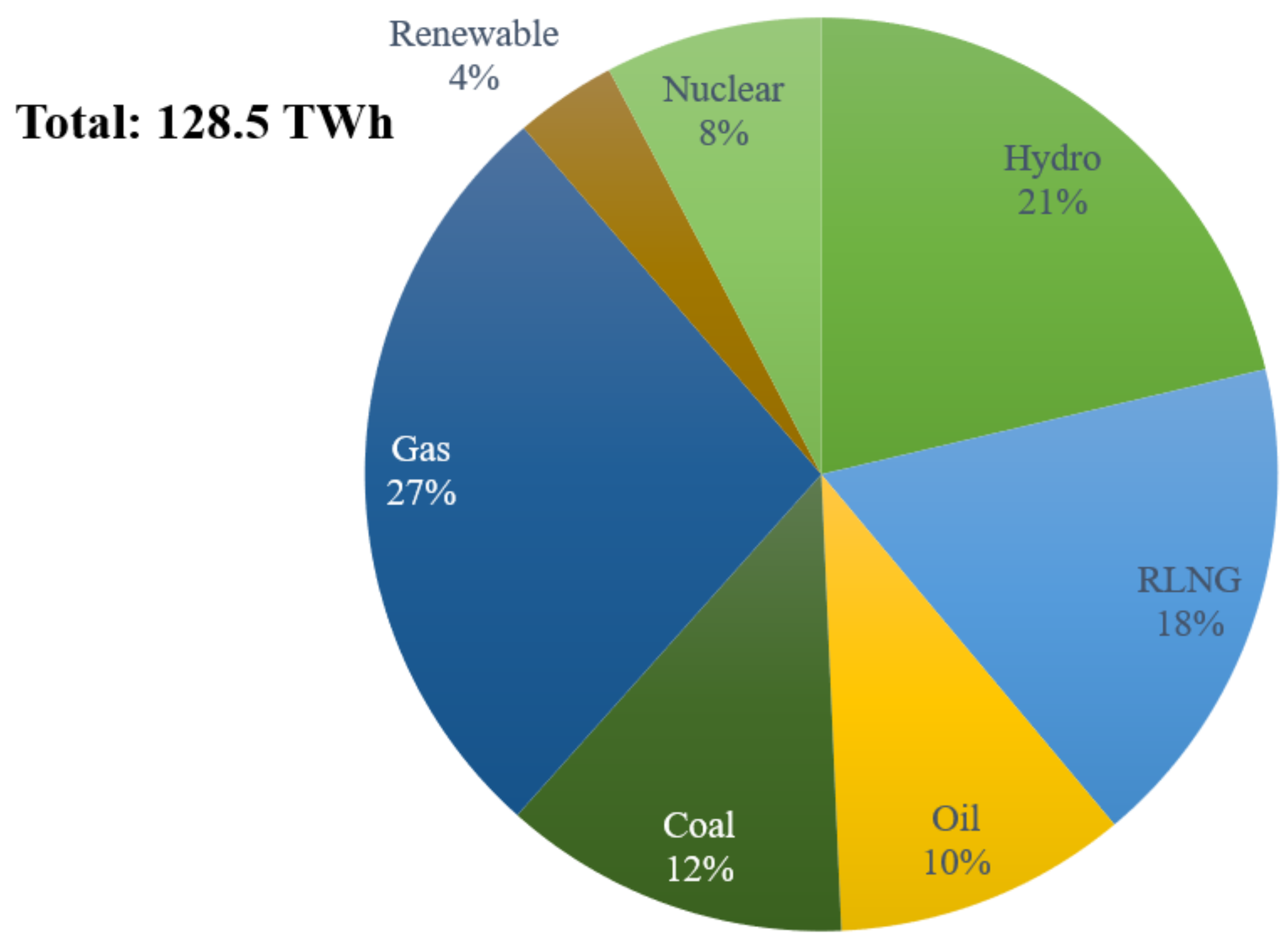

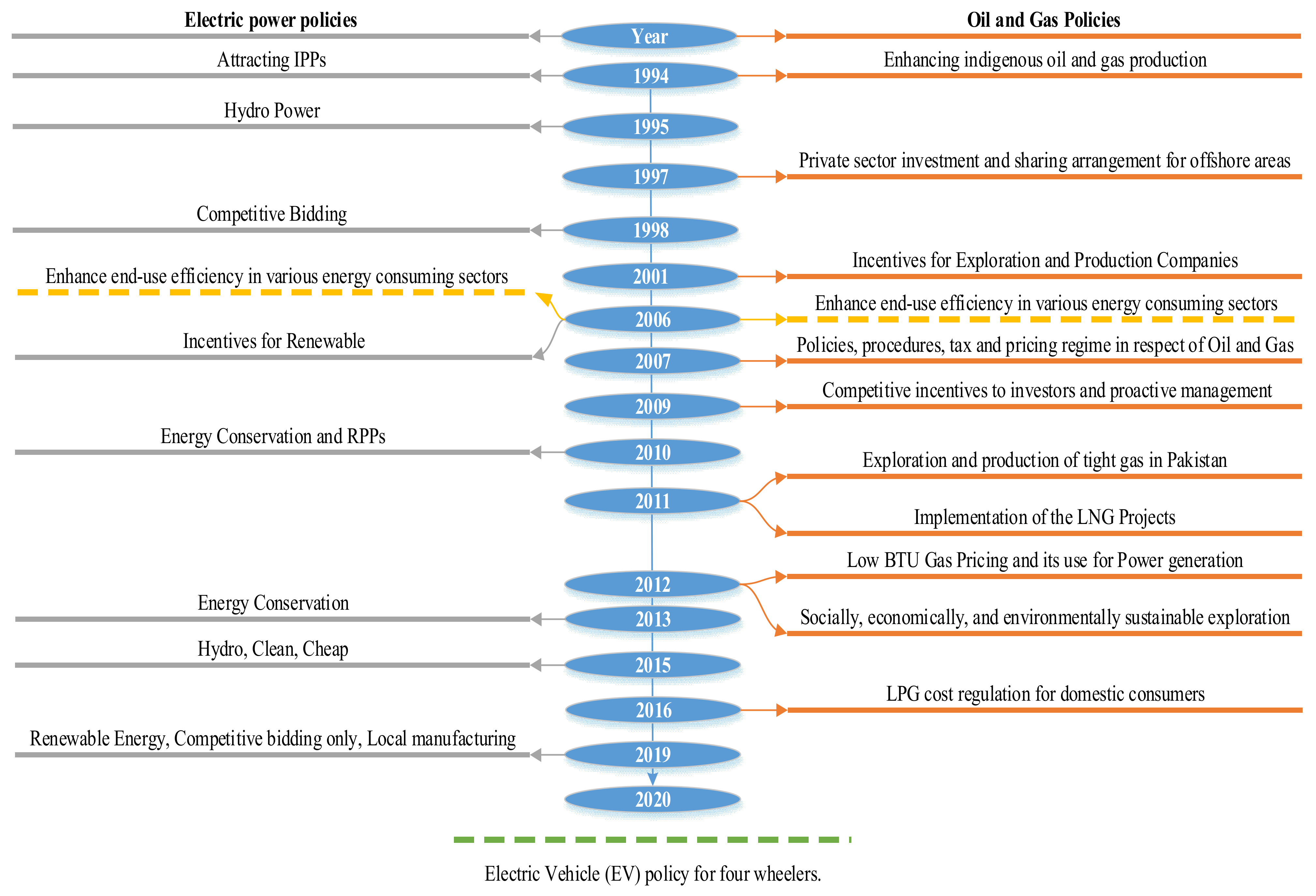
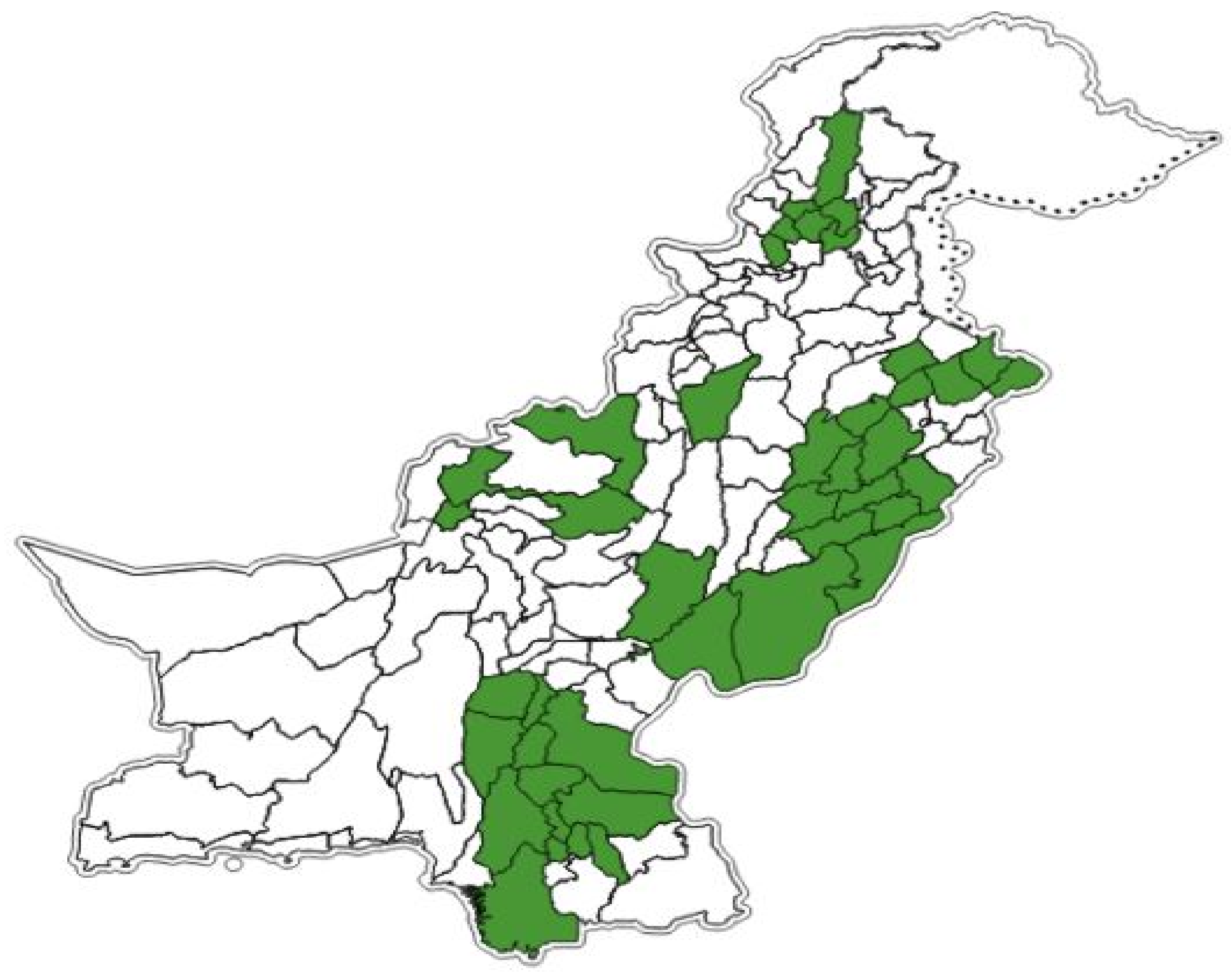
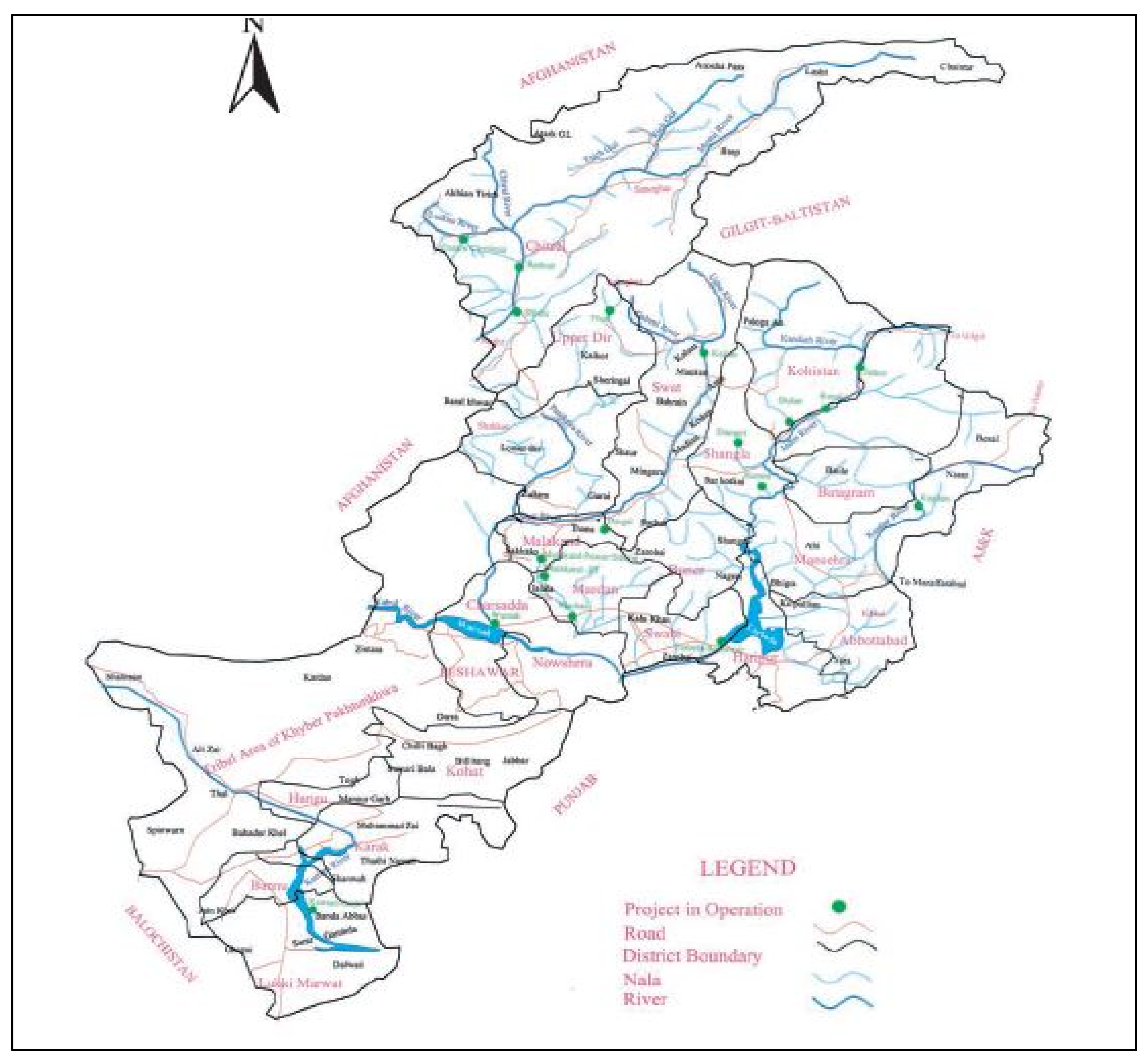
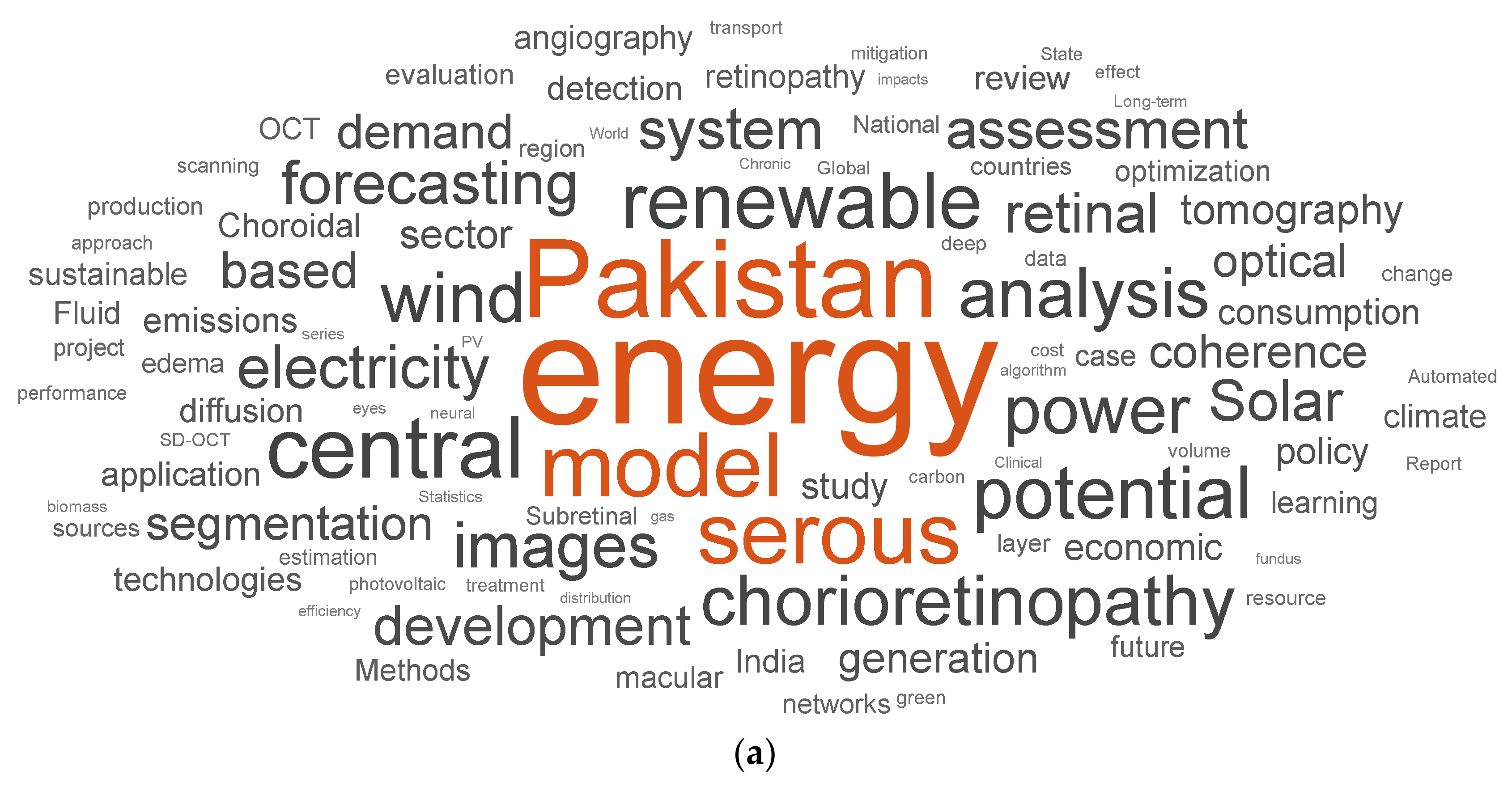
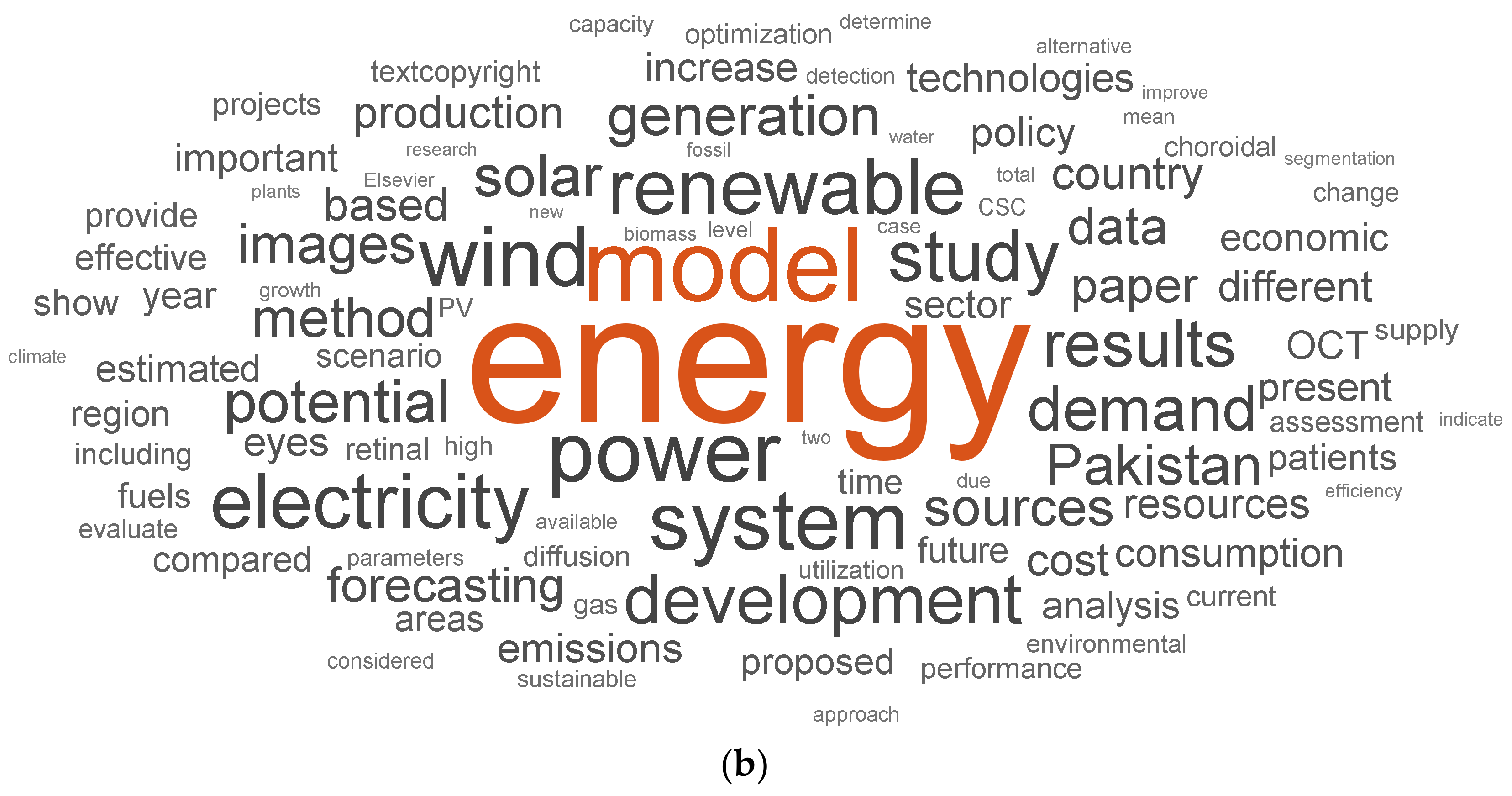
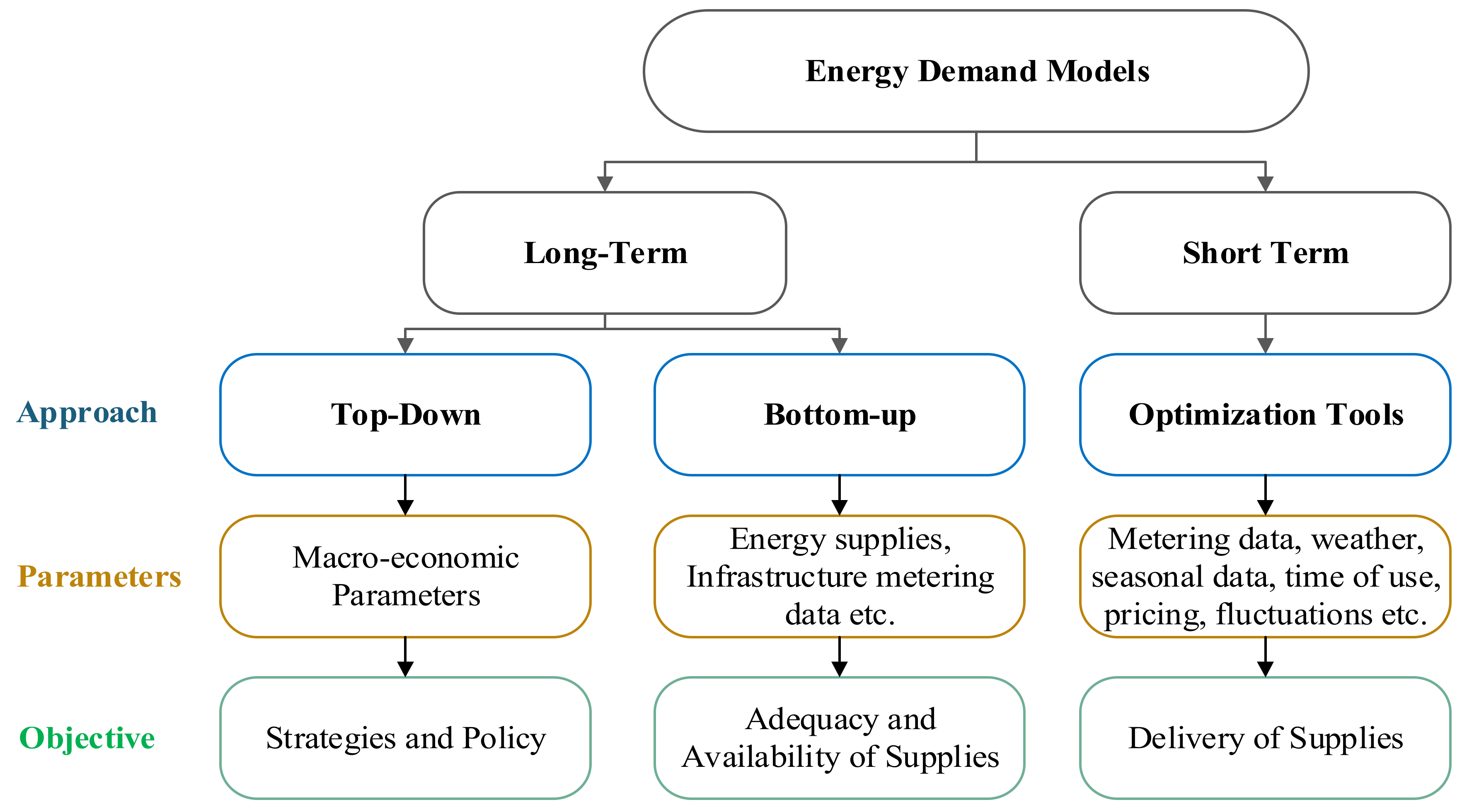

| Governing Ministry | The Ministry of Energy |
| Petroleum Division and Power Division | |
| Coordination | Energy Wing Planning Commission(policy formulations, legislation, and implementation) |
| Payments | Ministry of Finance |
| Regulatory body |
|
| Legitimate Framework | Upstream (E&P)
|
| Polices | Upstream (E&P)
|
| Rules and Regulation | Upstream (E&P)
|
| R&D |
|
| Production and Distribution companies | Oil and Gas
|
| Study | Initiator | Method/Tools | Key Focus | Limitations/ Challenges |
|---|---|---|---|---|
| Lieftricnk Report (1967) | World Bank |
|
|
|
| RESPAK Model (1988) | Planning Commission of GOP |
|
|
|
| Energy and nuclear power planning study for Pakistan (1994) | PAEC |
|
|
|
| National Power Plan (1994–2018) | WAPDA |
|
|
|
| Energy Security Action Plan (2005–2030) | Planning Commission of GOP |
|
|
|
| Pakistan Integrated Energy Model (2007) | International Resource Group |
|
|
|
| Overcoming Pakistan’s Energy Crisis (2014) | Wilson Centre |
|
|
|
| Electricity demand forecasting (2014–2037) | NTDC |
|
|
|
| Electricity demand forecasting (2014–2024) | DISCOsNTDC |
|
|
|
| National Power System Expansion Plan (2011) | NTDC |
|
|
|
| Least Cost Generation and Transmission Expansion plan (2015) | Japan International Cooperation Agency |
|
|
|
| Renewable Energy Mapping Project (2016) | World Bank and AEDB |
|
|
|
| Bankability of the Transport Sector | Karandaaz Pakistan |
|
|
|
| Integrated Energy Planning (IEP) Modeling for Sustainable Development (ongoing) | Planning and Development GOP and USAID |
|
|
|
| Organization | Ministry | Functions |
|---|---|---|
| Energy Wing | Planning Commission and Reforms |
|
| Power Division | Energy |
|
| Petroleum Division | Energy |
|
| National Energy Conservation Centre | Climate Change |
|
|
| Author (Year) | Summary | Study Area |
|---|---|---|
| Ghaffar et al. (1995) [20] | Estimated potential of biogas from dung for cooking and lighting in rural areas of Pakistan. Using a flat plate collector and solar PV, they also estimated the potential of solar energy in different locations in Pakistan. | Pakistan |
| Siemek, Nagy, and Rychlicki (2003) [21] | Estimated long-term natural gas demand employing logistic modeling for Poland. Used the Gauss-Newton algorithm for estimation of logistic model parameters. | Poland |
| Evrendilek and Ertekin (2003) [22] | Assessed the potential of hydro, wind, solar, and geothermal power, along with biogas and biofuels, in Turkey using secondary data. | Turkey |
| Uemura et al. (2004) [23] | Used data on wind speed, solar irradiance, biomass, waste, etc., to estimate the potential of wind power; solar, thermal, and PV electricity; and biomass energy. | Yakushima Island |
| Lund (2006) [24] | Estimated renewable energy diffusion in India using logistic modeling and estimated the model parameters according to the ordinary least square (OLS) principle. | India |
| Harijan (2008) [19] | Used a logistic modeling approach to estimate the long-term diffusion of wind energy for power and water pumping; solar energy for power and heating; biomass energy for power, transport, and cooking; and hydropower in Pakistan. The study estimated the parameters according to the OLS principle using analogous data. | Pakistan |
| Harijan et al. (2009) and Bhutto et al. (2015, 2016) [25,26] | Analyzed perspectives on biofuel production and its utilization for clean transportation. | Pakistan |
| Forouzanfar et al. (2010) [27] | Employed logistic modeling to forecast demand for natural gas of residential and commercial consumers of Iran. The genetic algorithm (GA) and nonlinear programming (NLP) were used to estimate model parameters. | Iran |
| Xu, Li, and Zheng (2016) [28] | Forecasted wind energy diffusion using wind energy generation technological paradigm diffusion. | China |
| Dalla Valle and Furlan (2011) [29] | Predicted the accuracy of wind power technology diffusion models across countries. | |
| Harijan et al. (2011) [30] | Used logistic modeling to forecast the diffusion of wind energy in Pakistan. The model parameters were estimated according to the OLS principle with analogous data. | Pakistan |
| Melikoglu (2013) [31] | Estimated long-term natural gas demand of Turkey with a logistic model. This study estimated parameters of the logistic model using the SigmaPlot 11 optimization tool and reported enhanced performance of a logistic model relative to a linear model. | Turkey |
| Farooq and Kumar (2013) [32] | Considered solar PV, parabolic trough, run of river, and biomass gasification technologies for assessment of solar, wind, hydro, and biomass (field residue, animal waste, and MSW) potential for electricity generation in Pakistan. They estimated production of field residue based on the residue-to-production ratio of crops in a year. Animal waste and MSW were estimated based on animal and waste growth. | Pakistan |
| Shami et al. (2016) [33] | Evaluated the wind energy potential of three provinces of Pakistan based on wind data and evaluated suitable geographical locations for the installation of grid-connected wind farms. | |
| Ali, Khan, and Masood (2017) [34] | Analyzed wind energy potential with an optimal wind blade design for the Jamshoro wind corridor. | |
| Kamran (2018) [35] | Reviewed the status of renewable energy in Pakistan. The results indicate that a changes in the energy mix with increasing share of renewable sources reduce the demand and supply gap and stimulate local and foreign investment in the energy sector of Pakistan. | Pakistan |
| Farooqui (2014) [36] | Surveyed the availability of hydro, solar, wind, and biomass, as well as their current and future penetration prospects in the energy mix of Pakistan. This study estimated 30 GW and 50 GW as the feasible potential of installed power capacity from hydro and wind, respectively, by 2030. | Pakistan |
| Udhayakumar et al. (2020) [37] | Employed moth flame optimization to assess both onshore and offshore wind energy potential. | India |
| Teimourian et al. (2020) [38] | Employed the Weibull probability density function and assessed wind energy potential of the southern provinces of Iran. | Iran |
| Nazari et al. (2020) [39] | Used the TOPSIS method for the selection of wind sites in Iran. | Iran |
| Shoaib et al. (2019) [40] | Assessed the wind energy potential of Jhampir using wind energy conversion systems. | Pakistan |
| Glasson (2021) [41] | Highlighted the evolution of UK offshore wind farms and their community benefits in a macro study on the adoption of community benefits. | UK |
| Cai et al. (2022) [42] | Investigated the integration of hydrogen storage systems and wind generation in a power system under a demand response program. | |
| Khatri et al. (2022) [43,44] | Used the System Advisor Model (SAM) to assess the technical potential of solar PV and wind power in Pakistan. Technology diffusion was forecasted using logistic modeling. LMA was used to estimate the parameters. This investigation concluded that 600×103 GWh/year of electricity would be generated through solar PV and 150×103 GWh/year of electricity would be generated from grid-connected wind power. | Pakistan |
| Power Policy | Capacity Addition (MW) | Fuel Sources | Remarks | |||
|---|---|---|---|---|---|---|
| Oil | Gas | Hydro | Other Renewables | |||
| 1994 | 2898 | 63% | 27% | - | - | High cost of generation resulting from imported fuel |
| 1995 | 94 | - | - | 100% | - | Insufficient capacity added to the system |
| 1998 | - | - | - | - | - | Political interference prevented the addition of power generation to the system |
| 2002 | 2782 | 42% | 58% | - | - | Costlier power generation as a result of foreign direct investment |
| 2006 | 355.4 | - | - | - | 100% | Wind- and solar-based electricity generation focused mostly in the southern part of the country |
| 2008 | 145.1 | - | - | - | 100% | Mostly captive power plants with a focus on the sugar industry |
| 2013 | 2019 | 58% | 19% | 17% | - | Limited share of RE resources dominated by thermal generation |
| 2015 | - | - | - | - | - | Under implementation |
Disclaimer/Publisher’s Note: The statements, opinions and data contained in all publications are solely those of the individual author(s) and contributor(s) and not of MDPI and/or the editor(s). MDPI and/or the editor(s) disclaim responsibility for any injury to people or property resulting from any ideas, methods, instructions or products referred to in the content. |
© 2022 by the authors. Licensee MDPI, Basel, Switzerland. This article is an open access article distributed under the terms and conditions of the Creative Commons Attribution (CC BY) license (https://creativecommons.org/licenses/by/4.0/).
Share and Cite
Khatri, S.A.; Mirjat, N.H.; Harijan, K.; Uqaili, M.A.; Shah, S.F.; Shaikh, P.H.; Kumar, L. An Overview of the Current Energy Situation of Pakistan and the Way Forward towards Green Energy Implementation. Energies 2023, 16, 423. https://doi.org/10.3390/en16010423
Khatri SA, Mirjat NH, Harijan K, Uqaili MA, Shah SF, Shaikh PH, Kumar L. An Overview of the Current Energy Situation of Pakistan and the Way Forward towards Green Energy Implementation. Energies. 2023; 16(1):423. https://doi.org/10.3390/en16010423
Chicago/Turabian StyleKhatri, Shoaib Ahmed, Nayyar Hussain Mirjat, Khanji Harijan, Mohammad Aslam Uqaili, Syed Feroz Shah, Pervez Hameed Shaikh, and Laveet Kumar. 2023. "An Overview of the Current Energy Situation of Pakistan and the Way Forward towards Green Energy Implementation" Energies 16, no. 1: 423. https://doi.org/10.3390/en16010423
APA StyleKhatri, S. A., Mirjat, N. H., Harijan, K., Uqaili, M. A., Shah, S. F., Shaikh, P. H., & Kumar, L. (2023). An Overview of the Current Energy Situation of Pakistan and the Way Forward towards Green Energy Implementation. Energies, 16(1), 423. https://doi.org/10.3390/en16010423







